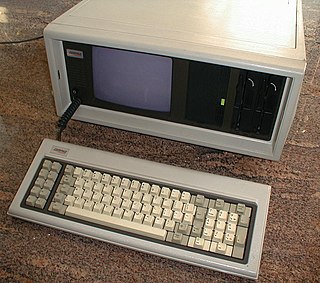
The Apple II series of microcomputers was initially designed by Steve Wozniak, manufactured by Apple Computer, and launched in 1977 with the Apple II model that gave the series its name. It was followed by the Apple II Plus, Apple IIe, Apple IIc, and Apple IIc Plus, with the 1983 IIe being the most popular. The name is trademarked with square brackets as Apple ][, then, beginning with the IIe, as Apple //. In terms of ease of use, features, and expandability, the Apple II was a major advancement over its predecessor, the Apple I, a limited-production bare circuit board computer for electronics hobbyists.

A graphical user interface, or GUI, is a form of user interface that allows users to interact with electronic devices through graphical icons and visual indicators such as secondary notation. In many applications, GUIs are used instead of text-based UIs, which are based on typed command labels or text navigation. GUIs were introduced in reaction to the perceived steep learning curve of command-line interfaces (CLIs), which require commands to be typed on a computer keyboard.

The history of the graphical user interface, understood as the use of graphic icons and a pointing device to control a computer, covers a five-decade span of incremental refinements, built on some constant core principles. Several vendors have created their own windowing systems based on independent code, but with basic elements in common that define the WIMP "window, icon, menu and pointing device" paradigm.

The IBM Personal Computer is the first microcomputer released in the IBM PC model line and the basis for the IBM PC compatible de facto standard. Released on August 12, 1981, it was created by a team of engineers and designers at International Business Machines (IBM), directed by William C. Lowe and Philip Don Estridge in Boca Raton, Florida.

The Power Macintosh, later Power Mac, is a family of personal computers designed, manufactured, and sold by Apple Computer, Inc as the core of the Macintosh brand from March 1994 until August 2006.

IBM PC–compatible computers are technically similar to the original IBM PC, XT, and AT, all from computer giant IBM, that are able to use the same software and expansion cards. Such computers were referred to as PC clones, IBM clones or IBM PC clones. The term "IBM PC compatible" is now a historical description only, since IBM no longer sells personal computers after it sold its personal computer division in 2005 to Chinese technology company Lenovo. The designation "PC", as used in much of personal computer history, has not meant "personal computer" generally, but rather an x86 computer capable of running the same software that a contemporary IBM PC could. The term was initially in contrast to the variety of home computer systems available in the early 1980s, such as the Apple II, TRS-80, and Commodore 64. Later, the term was primarily used in contrast to Apple's Macintosh computers.

A workstation is a special computer designed for technical or scientific applications. Intended primarily to be used by a single user, they are commonly connected to a local area network and run multi-user operating systems. The term workstation has been used loosely to refer to everything from a mainframe computer terminal to a PC connected to a network, but the most common form refers to the class of hardware offered by several current and defunct companies such as Sun Microsystems, Silicon Graphics, Apollo Computer, DEC, HP, NeXT, and IBM which powered the 3D computer graphics revolution of the late 1990s.

Lisa is a desktop computer developed by Apple, produced from January 19, 1983 to August 1, 1986, and succeeded by Macintosh. It is generally considered the first mass-market personal computer operable through a graphical user interface (GUI). In 1983, a machine like the Lisa was still so expensive that it was primarily marketed to individual and small and medium-sized businesses as a groundbreaking new alternative to much bigger and more expensive mainframes or minicomputers such as from IBM, that either require additional, expensive consultancy from the supplier, hiring specially trained personnel, or at least, a much steeper learning curve to maintain and operate. Earlier GUI-controlled personal computers were not mass-marketed; for example, Xerox PARC manufactured its Alto workstation only for Xerox and select partners from the early to mid-1970s.

The TI-99/4 and TI-99/4A are home computers released by Texas Instruments in 1979 and 1981, respectively. Based on Texas Instruments's own TMS9900 microprocessor originally used in minicomputers, the TI-99/4 was the first 16-bit home computer. The associated TMS9918 video display controller provides color graphics and sprite support which were only comparable with those of the Atari 400 and 800 released a month after the TI-99/4. The TI-99 series also initially competed with the Apple II and TRS-80.
Convergent Technologies, Inc., was an American computer company formed by a small group of people who left Intel Corporation and Xerox PARC in 1979. Among the founders were CEO Allen Michels, VP Engineering Bob Garrow, head of marketing Kal Hubler, and operating system architect Ben Wegbreit. Convergent was primarily an OEM vendor with their computers resold by other manufacturers such as ADP, AT&T, Burroughs, Four-Phase Systems, Gould, Mohawk, Monroe Data Systems, NCR, and Prime. The company was purchased by Unisys in 1988.

The Compaq Portable is an early portable computer which was one of the first IBM PC compatible systems. It was Compaq Computer Corporation's first product, to be followed by others in the Compaq Portable series and later Compaq Deskpro series. It was not simply an 8088-CPU computer that ran a Microsoft DOS as a PC "work-alike", but contained a reverse-engineered BIOS, and a version of MS-DOS that was so similar to IBM's PC DOS that it ran nearly all its application software. The computer was also an early variation on the idea of an "all-in-one".
The Apple 80-Column Text Card is an expansion card for the Apple IIe computer to give it the option of displaying 80 columns of text instead of 40 columns. Two models were available; the cheaper 80-column card has just enough extra RAM to double the video memory capacity, and the Extended 80-Column Text Card has an additional 64 kilobytes of RAM, bringing the computer's total RAM to 128 KB.

The Z-80 SoftCard is a plug-in Apple II processor card developed by Microsoft to turn the computer into a CP/M system based upon the Zilog Z80 central processing unit (CPU). Becoming the most popular CP/M platform and Microsoft's top revenue source for 1980, it was eventually renamed the Microsoft SoftCard, and was succeeded by Microsoft's Premium Softcard IIe for the Apple IIe.
Microsoft Corporation has been selling branded hardware since 1980, and developing devices in-house since 1982, when the Microsoft Hardware division was formed to design a computer mouse for use with Microsoft Word for DOS. Since then, Microsoft has developed computer hardware, gaming hardware and mobile hardware. It also produced drivers and other software for integrating the hardware with Microsoft Windows.

The history of the personal computer as a mass-market consumer electronic device began with the microcomputer revolution of the 1970s. A personal computer is one intended for interactive individual use, as opposed to a mainframe computer where the end user's requests are filtered through operating staff, or a time-sharing system in which one large processor is shared by many individuals. After the development of the microprocessor, individual personal computers were low enough in cost that they eventually became affordable consumer goods. Early personal computers – generally called microcomputers – were sold often in electronic kit form and in limited numbers, and were of interest mostly to hobbyists and technicians.

The HP 110 is an MS-DOS-compatible laptop released in 1984 by Hewlett-Packard. It runs off batteries and uses a Harris 80C86 running at 5.33 MHz with 272 KB of RAM. It has an 80 character by 16 line monochrome liquid crystal display, runs MS-DOS 2.11 in ROM, and has the application programs MemoMaker, Terminal Emulator and Lotus 1-2-3 in ROM.
A legacy-free PC is a type of personal computer that lacks a floppy or optical disc drive, legacy ports, and an Industry Standard Architecture (ISA) bus. According to Microsoft, "The basic goal for these requirements is that the operating system, devices, and end users cannot detect the presence of the following: ISA slots or devices; legacy floppy disk controller (FDC); and PS/2, serial, parallel, and game ports." The legacy ports are usually replaced with Universal Serial Bus (USB) ports. A USB adapter may be used if an older device must be connected to a PC lacking these ports. According to the 2001 edition of Microsoft's PC System Design Guide, a legacy-free PC must be able to boot from a USB device.
Corona Data Systems, later renamed Cordata, was an American personal computer company. It was one of the earliest IBM PC compatible computer system companies. Manufacturing was primarily done by Daewoo of Korea, which became a major investor in the company and ultimately the owner.
The M&R Enterprises Sup'R'Terminal was the first Apple II peripheral card to enable the display of 80 columns of text on a connected monitor. The Sup'R'Terminal is compatible with slot 03 in the Apple II and II+. As the first card making 80 columns of upper and lower case text displayable on these machines, it is the only card supported by the II+ version of Apple Writer and thus the only way to see on a monitor the true layout of text as it will be printed on a page with this popular early personal computer word processor. The Apple II and II+ had until this time only displayed 40 columns of text per line, half the characters included per line on a standard letter-size printed page at 10 characters per inch. This transition to 80-column display was an early step in bringing the WYSIWYG concept to the Apple ecosystem.

Jonos International, Inc., originally Jonos, Ltd. (JL), later Netcom Research, Inc., was an American computer company active from 1980 to 1992. The company sold a variety of computer hardware products and systems, including STD Bus peripherals, smart terminals, microcomputers, and portable computers. The company's Courier portable computer was the first microcomputer sold with Sony's then-new 3.5-inch floppy disk drives on its release in June 1982. Jonos' systems were widely used in the fields of construction, roadworks, machining, and military.












